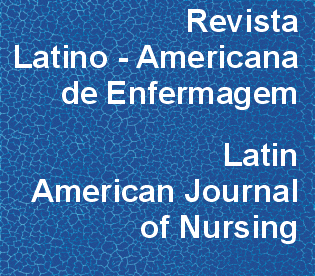Cohort study of institutionalized elderly people: fall risk factors from the nursing diagnosis
DOI:
https://doi.org/10.1590/0104-1169.0285.2658Abstract
Objective: to determine the incidence of falls in elderly residents of long-stay institutions of the Federal District, to identify the aspects involved in the falls, in terms of risk factors, from the application of scales and the Taxonomy II of NANDA-I, and to define the level of accuracy with its sensitivity and specificity for application in the clinical nursing practice. Method: this was a cohort study with the evaluation of 271 elderly people. Cognition, functionality, mobility and other intrinsic factors were evaluated. After six months, the elderly people who fell were identified, with significance analysis then performed to define the risk factors. Results: the results showed an incidence of 41%. Of the 271 patients included, 69 suffered 111 episodes of falls during the monitoring period. Risk factors were the presence of stroke with its sequelae (OR: 1.82, 95% CI 1.01 - 3.28, p=.045), presenting more than five chronic diseases (OR: 2.82, 95% CI 1.43 - 5.56, p=.0028), foot problem (OR: 2.45, 95% CI 1.35 - 4.44, p=.0033) and motion (OR: 2.04, 95% CI 1.15 - 3.61, p=.0145). Conclusion: the taxonomy has high validity regarding the detection of elderly people at risk of falling and should be applied consistently in the clinical nursing practice.Downloads
Download data is not yet available.
Downloads
Published
2015-12-01
Issue
Section
Original Articles
License
RLAE’s authorship concept is based on the substantial contribution by each of the individuals listed as authors, mainly in terms of conceiving and planning the research project, collecting or analyzing and interpreting data, writing and critical review. Indication of authors’ names under the article title is limited to six. If more, authors are listed on the online submission form under Acknowledgements. The possibility of including more than six authors will only be examined on multicenter studies, considering the explanations presented by the authors.Including names of authors whose contribution does not fit into the above criteria cannot be justified. Those names can be included in the Acknowledgements section.
Authors are fully responsible for the concepts disseminated in their manuscripts, which do not necessarily reflect the editors’ and editorial board’s opinion.
How to Cite
Reis, K. M. C. dos, & Jesus, C. A. C. de. (2015). Cohort study of institutionalized elderly people: fall risk factors from the nursing diagnosis . Revista Latino-Americana De Enfermagem, 23(6), 1130-1138. https://doi.org/10.1590/0104-1169.0285.2658



